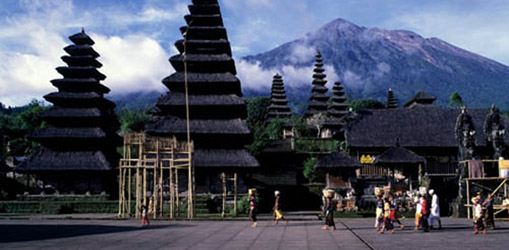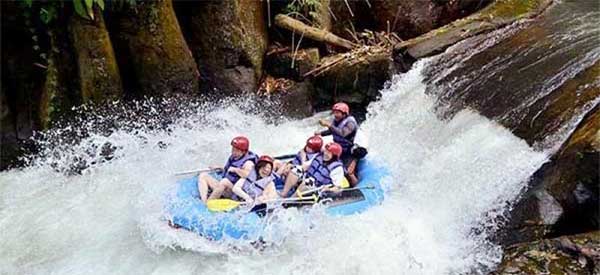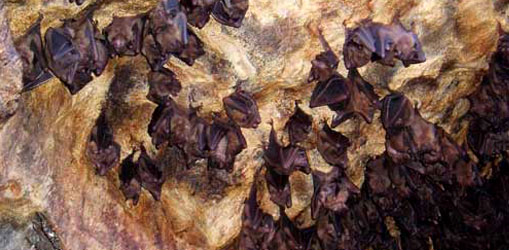Located :
The location of Besakih Temple or Pura Agung Besakih is at Besakih Village, Rendang District, on the south west of Mount Agung. It is about 1.000 meters above the sea level, 44 kilometers from Amlapura, 13 kilometers from closest city Klungkung and 62 kms from the main city of Denpasar.
Descriptions :
Perched nearly 1000 m up the side of Gunung Agung is Bali’s most important temple, Pura Besakih. In fact it is an extensive complex of some 23 separate but related temples, with the largest and most important being Pura Penataran Agung. It is most enjoyable during one of the frequent festival, when hundreds perhaps thousands, of gorgeously dressed devotees turn up with beautifully arranged offerings. The panoramic view and the mountain backdrop are impressive too. Despite its importance to the Balinese, Besakih can be a disappointment to visitors. The architecture is not especially impressive, tourists are not allowed inside any of the temple compound, and the views are usually obscured by mist.
History :
Besakih was built on a terraced site where prehistoric rites, ceremonies, and feasts once took place. Perhaps it was here where the spirit of the great, angry mountain, which loomed menacingly above the island, received pagan sacrifices. Certain timeworn megaliths in some of the bale are reminiscent of old Indo-Polynesian structures. Hindu theologians claim the temple was founded by the 8th century missionary Danghyang Markandeya, a priest credited with introducing the tradition of daily offerings (bebali) and the concept of a single god. His son, Empu Sang Kulputih, was the temple’s first high priest. The first record of the temple’s existence is a chronogram dated AD 1007, possibly describing the death ritual for King Udayana’s queen, Mahendradatta. This inscription also reveals that Besakih was used as a Buddhist sanctuary. ‘Lontar’ books dating from the Majapahit Kingdom indicate Besakih’s significance during the 14th century, and several 15th-century wood tablets refer to state support of Besakih, confirming its preeminence.
Besakih’s central Pura Penataran Agung, the largest on the island, functioned as a funeral temple for the Gelgel dynasty’s deified kings and as the central state temple for the entire island. Gelgel rulers are today enshrined in their own temple here, the Padharman Dalem. For centuries worship at Besakih was the exclusive privilege of rajas, not commoners, and the difficult trek here in former times reinforced the ardor of the devotional act. The great 1917 earthquake destroyed the temple complex, but it was subsequently restored by the Dutch to its original form (only two structures survived this quake). Besakih was again heavily damaged on 17 March 1963 by a Gunung Agung eruption. The complex has since been extensively restored and now encompasses a mix of old and new buildings. Because it is a state shrine, the provincial and national governments pay for its upkeep. Layout and Design Besakih is a very complex architectural structure venerating the holy Hindu trinity.
Via a series of long stairways, the temple group ascends parallel ridges toward Gunung Agung, the honored birthplace of Bali’s deities, tantamount to heaven. The temple is continually enlarged as municipalities, regencies, and wealthy honored Brahman families add more shrines. In fact, each caste and kin group, as well as various sects, artisan guilds, and aristocratic families, maintains its own temple inside the complex. About 22 separate sanctuaries contain a befuddling array of over 60 temples and 200 distinct structures (a map is posted at the top of the road leading from the parking lot). Given the Balinese passion for covering surfaces with carving or paint, it’s remarkable most of Besakih’s sanctuaries are constructed simply of wood. The sun god (Bhatara Surya), the god of the sea (Ratu Waruna), and every major figure in the Balinese pantheon is represented here.
Each of the island’s nine regencies also maintains its own temple within this complex. Curiously, the small, relatively inconsequential ‘rajadoms’ like Blahbatuh and Sukawati are assigned proportionally large sections, while major regencies like Badung and Gianyar are meagerly represented. The historical importance of the Gelgel kingdom is evident, however, by its assignment to the innermost, central courtyard. Beyond a great unadorned split gate, a broad terrace leads to a ‘Gapura’, which opens onto 50 black, slender, pagoda-like ‘Meru’ temples. The more roofs, the higher-ranking the god or deified ancestor to whom the ‘Meru’ is dedicated. Long flights of stone steps lead to the main central temple, Pura Penataran Agung, which consists of six rising terraces built on a slope, all connected by gateways. In the third inner court of the central temple is the Sanggar Agung’, a beautifully decorated 17th-century triple lotus stone throne representing the divine triad.
This is the ritual center of Besakih. Through the clear, fresh air of the topmost terrace, over 900 meters above sea level, is an unsurpassed view over spectacular rice terraces. Behind, thick white clouds hover over Gunung Agung. Besakih’s three main temples, which stretch for over a kilometer, are Pura Penataran Agung (in the symbolic center), dedicated to the paramount god Shiva, or Sanghyang Widhi Wasa; Pura Kiduling Kreteg, honoring Brahma; and Pura Batu Medog, dedicated to Vishnu. The longitudinal axis of this complex points directly ‘Kaja’, toward Gunung Agung’s peak to the northeast. Farther up the mountain is another compound, Pura Gelap, the “Thunderbolt Temple.” Highest, in the pine forests of Agung’s southwest slope, is austere Pura Pengabengan.
Religious Ceremony
There are various ceremonies which are conducted in Besakih Temple. There are 12 ceremonies conducted every 210 days. This is based on Hindu – Java calendar which is consisting of 30 months and one month consist of 7 days. Each temple complex has its own ceremony based on this dates. Special ceremony based on Çaka year is conducted 6 times a year. This ceremony is called “Ngusaba “, a kind of blessing ceremony. At the other village temples in Bali this type of ceremony is also conducted in relation with rice harvesting, especially in the regency of Gianyar.
During the Ngusaba ceremony in Gianyar there is a very long procession of girls dressed in Balinese traditional costumes, and women with offering on their head, followed with deafening sound of Balinese traditional music. A ceremony called “Betara Turun Kabeh ” is conducted every year.” Betara Turun Kabeh “means all gods are presence. This is the biggest yearly ceremony. While a ceremony every 10 years called “Paca Wali Karma” and a ceremony every 100 years called “Eka Dasa Rudra”. All dates for above ceremony can be known in December for the following year, when Bali calendar has been issued. Normally Bali calendar already at the shop latest by December every year.
How to get to Besakih Temple :
1. 1,5 hours from Karangasem
2. 2.5 hours from Denpasar
3. 40 minutes from Kintamani
What you can see around Besakih Temple :
1. Tenganan Pegeringsingan, As an ancient village, Tenganan Pegeringsingan is identical with religious activities. Many temple festivals performed in this village that attract visitors to come. The most famous one is “Mekare-kare” or “Perang Pandan”. This is a ceremonial fight or war using thorny pandanous leaves as the weapon.
2. Telaga Waja River, flows below Bali’s highest peak, Mt. Agung, an active volcano that last erupted in the 1960’s. Many Balinese regard the mountain as sacred—which lends a unique touch to Telaga Waja River rafting trips—and you might even see ash or smoke rising from Agung.
3. Kerta Gosa Courts of Justice, the more famous painted ceiling of the Kerta Gosa has also gone through numerous changes this century. It had to be restored after the devastating earthquake of 1917 and was again repainted during the 1930’s by Pan Sekan, a master artist from nearby village of Kamasan.









